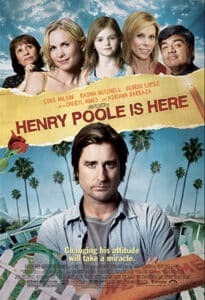
Actor Luke Wilson’s career has taken a considerable nosedive over the past few years. In recent times he’s found himself relegated to the ignominy of virtual direct-to-DVD releases (Idiocracy, Blonde Ambition – playing second fiddle to Jessica Simpson no less) or unnecessary cameos (3:10 to Yuma, Blades of Glory). Of course, he was never a huge star, to begin with, but there was a period not too long ago when he appeared in a string of critical and commercial successes.
His last major studio release, My Super Ex-Girlfriend in 2006, was a huge flop, and his directorial debut, The Wendell Baker Story (2005), albeit quaint, barely registered with anyone. His latest film, Mark Pellington‘s Henry Poole Is Here, continues this trend with its blink-and-you-missed-it summer release and general critical drubbing. Yet Wilson hasn’t been subject to damning headlines or career autopsy reports. I guess being so darn affable has its benefits when it comes to dealing with the Hollywood press.
In Henry Poole Is Here, Wilson plays a glum guy with little interest in anything or anyone who moves into a house in a small California neighborhood under mysterious circumstances. Despite repeatedly insisting he wants to be left alone, he works very hard to foster his mysterious reputation by giving cryptic responses to neighbors that imply more than they need to. “If you didn’t want to talk about it, you wouldn’t have brought it up,” a character finally says, calling his bluff.
Henry receives more unwanted attention when an image of Christ “appears” on the side of his house. Everyone in the neighborhood is captivated. Henry insists it’s merely a stain, the product of a lousy stucco job, but his chatterbox neighbor Esperanza (Adriana Barraza) insists that what has appeared is the face of God. A tussle ensues between Henry and the various members of the community, all eager to witness what they believe is a miracle. Eventually, Henry’s sullen demeanor wears off as he warms to the charms of the hot single mom next door (Radha Mitchell).
Wilson, who proved he can play taciturn very well in The Royal Tenenbaums and is a master of aw-shucks charm in sundry other roles, shows the limits of his range here as he can’t pull off prickly. His puppy dog eyes constantly belie the indignation his character purports to carry. As such, the character comes off as mildly perturbed rather than completely dejected, and Henry Poole Is Here becomes increasingly tedious.
While sentimental, the film avoids the maudlin by resisting a 180-degree character turn for Henry. As he slowly starts to embrace life, his behaviors never appear completely out of character; a commendable move on the part of screenwriter Albert Torres, but also something that renders the film ineffectual considering the plot expectations. Ultimately, Henry Poole Is Here isn’t religious enough to be shown in Sunday school but has enough of a Christian bent that if it were a book, it would be shelved in the Christian Inspiration section.
Henry Poole Is Here reminds me of Craig Gillespie’s Lars and the Real Girl (2007), in that both films concern a troubled young man receiving support from a community that rallies together with unquestionable faith that they can help him through his situation. Although unlike in Gillespie’s lovely film, with Henry Poole Is Here, one wonders if Henry deserves salvation. Bland and without much display of humanity, he doesn’t display much potential for growth. I certainly don’t know what Radha Mitchell’s character, Dawn Stupek, finds interesting about him aside from his convenient location. But I guess that’s where the Christian Inspiration element comes in: no one is beyond salvation, not even boring Henry.
The ambiguity of perception is notoriously difficult to convey in cinema. (Is the mark on Henry’s wall a stain? Is it a depiction of God? Does it matter?) Images generally alternate between the apparent and the incoherent (e.g., the action scenes in Transformers), with barely any room for middle-ground ambiguity. Not that it can’t be achieved; one need only think of the masterful conveyance of seeing versus not seeing in Antonioni’s Blow-Up (1966) and Dario Argento’s Profondo rosso (1975), the latter perhaps the greatest trompe l’oeil in all of cinema.
Henry Poole Is Here elides this issue by presenting the stain/face with swirling cameras and fleeting shots that give the viewer precious little time to regard the image itself. Later, the film introduces POV shots from within the wall that endows the stain/face with an ethereal quality.
The DVD of this film offers some comparably underwhelming special features that include two incredibly bland music videos for slightly less bland songs, a misrepresentative trailer, an audio commentary by director Mark Pellington and screenwriter Torres and a 20-minute making-of featurette. The featurette is mostly promotional backslapping rather than actual insight into the behind-the-scenes process, although it does give a few glimpses of Pellington’s hands-on approach to filmmaking. The most interesting element is seeing the cast and crew interacting with the real-life community of the small California neighborhood where they filmed.
There’s also a good amount of the cast and crew praising Wilson’s languid charm on-screen and off. Even with lingering memories of his weak performance in the film, listening to their stories and hearing Wilson speak is enough to remember why he always seems to escape the brunt of public scorn.


![Call for Papers: All Things Reconsidered [MUSIC] May-August 2024](https://www.popmatters.com/wp-content/uploads/2024/04/all-things-reconsidered-call-music-may-2024-720x380.jpg)



